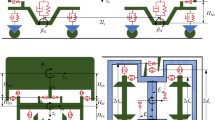Abstract
This paper presents a dynamic analytical model for tank train vibrations. The train is considered as a system of 27 degrees of freedom consisting of lateral, roll, yaw, vertical, and pitch motions for the vehicle body and its two bogies and lateral, roll and vertical motions for the four wheel-sets. Liquid sloshing in the tank is modeled using an equivalent mechanical mass-spring model. Coupling between the vehicle system and the railway track is realized through the interaction forces between the train and the rail, where the vertical and lateral irregularity profiles of the track are regarded as stationary ergodic Gaussian random processes and simulated by polynomial functions. Random vibration theory is used to obtain the response power spectral densities. Finally, numerical results for a typical test case including natural frequencies of a coupled system, frequency response functions, and output power spectral densities are presented.















Similar content being viewed by others
References
Zhai W, Sun X (1994) A detailed model for investigating vertical interaction between railway vehicle and track. Veh Syst Dyn 23(S1):603–615
Zhai WM, Cai CB, Guo SZ (1996) Coupling model of vertical and lateral vehicle/track interactions. Veh Syst Dyn 26(1):61–79
Sun YQ, Dhanasekar M (2002) A dynamic model for the vertical interaction of the rail track and wagon system. Int J Solids Struct 39(5):1337–1359
Sun W, Gong D, Zhou J, Zhao Y (2011) Influences of suspended equipment under car body on high-speed train ride quality. Proc Eng 16:812–817
Nejlaoui M, Ajmi H, Zouhir A, Lotfi R (2013) Dynamic modeling of rail vehicle traveling at high speed. Design and modeling of mechanical systems. Springer, Berlin, pp 217–224
Wang W, Zhang Y, Ouyang H (2017) An iterative method for solving the dynamic response of railway vehicle–track coupled systems based on prediction of wheel-rail forces. Eng Struct 151:297–311
Fryba L (1996) Dynamics of railway bridges. Thomas Telford Publishing, London
Lei X, Noda NA (2002) Analyses of dynamic response of vehicle and track coupling system with random irregularity of track vertical profile. J Sound Vib 258(1):147–165
Lu F, Kennedy D, Williams FW, Lin JH (2008) Symplectic analysis of vertical random vibration for coupled vehicle–track systems. J Sound Vib 317(1):236–249
Zhang YW, Lin JH, Zhao Y, Howson WP, Williams FW (2010) Symplectic random vibration analysis of a vehicle moving on an infinitely long periodic track. J Sound Vib 329(21):4440–4454
Xu WT, Zhang YH, Lin JH, Kennedy D, Williams FW (2011) Sensitivity analysis and optimization of vehicle–bridge systems based on combined PEM–PIM strategy. Comput Struct 89(3):339–345
Sun W, Zhou J, Thompson D, Gong D (2014) Vertical random vibration analysis of vehicle–track coupled system using Green’s function method. Veh Syst Dyn 52(3):362–389
Xu L, Zhai W (2017) Stochastic analysis model for vehicle–track coupled systems subject to earthquakes and track random irregularities. J Sound Vib 407:209–225
Styles DD, Dodds CJ (1976) Simulation of random environments for structural dynamics testing. Exp Mech 16(11):416–424
Ammon D (1992) Problems in road surface modelling. Veh Syst Dyn 20(sup1):28–41
Türkay S, Hüseyin A (2005) A study of random vibration characteristics of the quarter-car model. J Sound Vib 282(1):111–124
Bogsjö K (2008) Coherence of road roughness in left and right wheel-path. Veh Syst Dyn 46(S1):599–609
De Filippis G, Palmieri D, Soria L, Mangialardi L (2017) System and source identification from operational vehicle responses: a novel modal model accounting for the track-vehicle interaction. arXiv preprint arXiv:1702.08325
Graham EW, Rodriquez AM (1951) The characteristics of fuel motion which affects airplane dynamics. Douglas Aircraft Co Inc., Santa Monica
Abramson HN, Silverman S (1966) The dynamic behavior of liquids in moving containers. NASA SP-106, NASA, Washington, DC, USA
Ibrahim RA (2005) Liquid sloshing dynamics: theory and applications. Cambridge University Press, Cambridge
Housner GW (1957) Dynamic pressures on accelerated fluid containers. Bull Seismol Soc Am 47(1):15–35
Pinson LD (1964) Longitudinal spring constants for liquid-propellant tanks with ellipsoidal ends. NASA TN D-2220, Langley Research Center, Washington, DC, USA
Bauer HF (1966) Nonlinear mechanical model for the description of propellant sloshing. AIAA J 4(9):1662–1668
Li Y, Wang J (2012) A supplementary, exact solution of an equivalent mechanical model for a sloshing fluid in a rectangular tank. J Fluids Struct 31:147–151
Ebrahimian M, Noorian MA, Haddadpour H (2014) Equivalent mechanical model of liquid sloshing in multi-baffled containers. Eng Anal Bound Elem 47:82–95
Author information
Authors and Affiliations
Corresponding author
Ethics declarations
Conflict of interest
The authors declare that they have no conflict of interest.
Rights and permissions
About this article
Cite this article
Nokhbatolfoghahai, A., Noorian, M.A. & Haddadpour, H. Dynamic response of tank trains to random track irregularities. Meccanica 53, 2687–2703 (2018). https://doi.org/10.1007/s11012-018-0849-8
Received:
Accepted:
Published:
Issue Date:
DOI: https://doi.org/10.1007/s11012-018-0849-8




